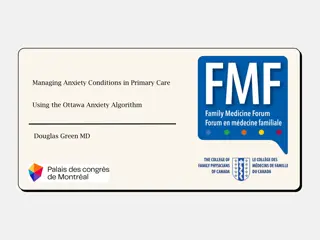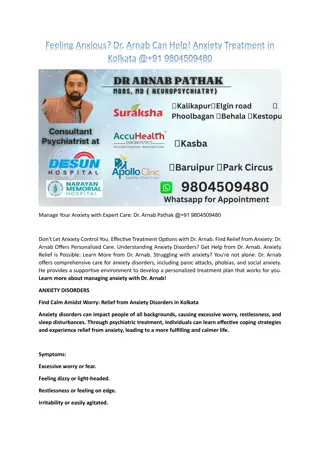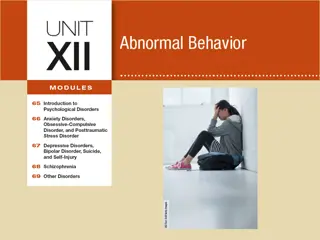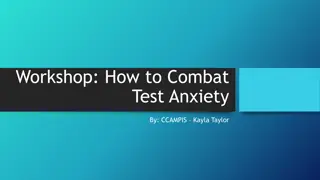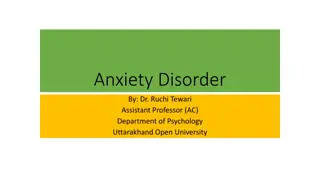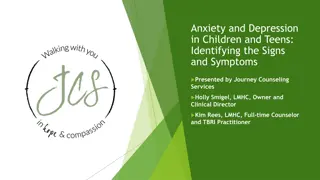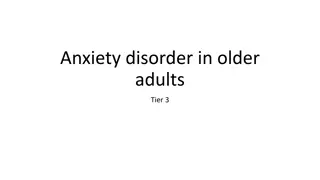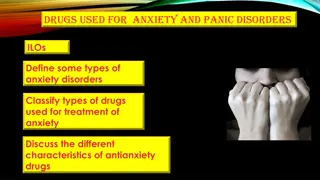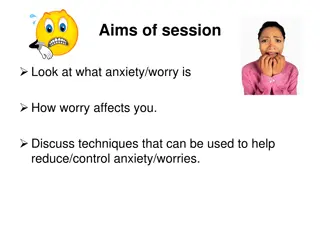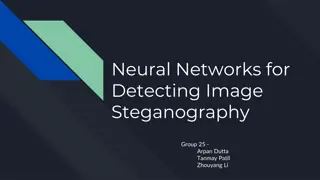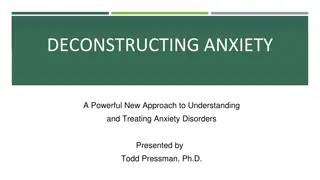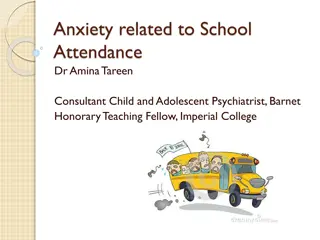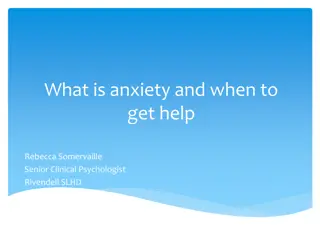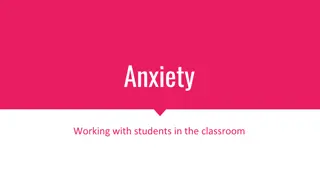Neural Systems in Detecting Threats and Managing Anxiety
The neural systems involved in detecting threats and regulating behavioral responses include the Hippocampus, Medial Cortex, Medial Prefrontal Cortex, Amygdala, and more. Anxiety is discussed as an adaptive response with normal and pathological aspects, leading to various anxiety disorders like Generalized Anxiety Disorder and Obsessive-Compulsive Disorder. Treatment options for these disorders are explored, emphasizing therapy and medication choices for better management.
Download Presentation

Please find below an Image/Link to download the presentation.
The content on the website is provided AS IS for your information and personal use only. It may not be sold, licensed, or shared on other websites without obtaining consent from the author.If you encounter any issues during the download, it is possible that the publisher has removed the file from their server.
You are allowed to download the files provided on this website for personal or commercial use, subject to the condition that they are used lawfully. All files are the property of their respective owners.
The content on the website is provided AS IS for your information and personal use only. It may not be sold, licensed, or shared on other websites without obtaining consent from the author.
E N D
Presentation Transcript
Neural systems involved in detecting threats and regulating behavioral and autonomic responses Memory consolidation of emotional events Hippocampus Medial Cortex Medial Prefrontal Amygdala Periaqueductal Gray Bed Nucleus of the Stria Terminalis Autonomic, somatic signs of anxiety Autonomic, somatic signs of fear stereotyped defensive reactions to threat (immobility and panic) autonomic and motor responses to threat (tachicardia, sweating) conditioned (learnt) anxiety responses unconditioned (innate) anxiety responses
ANXIETY Anxiety is an adaptive response that enables the individual to recognize danger and deal with an unknown vague internal or external threat Normal anxiety is an advantageous response to a threatening situation that accompanies many aspects of life Pathological anxiety is an inappropriate response to an internal or external stimulus Anxietydisorders are characterized by feelings of anxiety and fear and inappropriate severe and prolonged anticipation of negative event Symptoms can range from mild to severe. It is more a chronic than an episodic disorder
Anxiety Disorders Generalized anxiety disorder (GAD): general symptoms of motor tension, autonomic hyperactivity, etc. for at least one month Phobic anxiety: Simple phobias (Agoraphobia, fear of animals, etc.) Social phobias Panic disorders: Characterized by acute attacks of fear as compared to the chronic presentation of GAD Obsessive-compulsive behaviors (OCB): repetitive ideas (obsession: a persistent idea, image or desire) and behaviors (compulsion: a strong impulse to perform an act, especially one that is irrational or contrary to one's will) Post-traumatic stress disorders (PTSD)
GENERALIZED ANXIETY DISORDER First-line therapy Second-line therapy benzodiazepines (early onset of action but adverse effects) partial 5-HT1A receptor agonist (buspirone) for comorbidity with alcohol dependence and add-on SSRI therapy Inhibitors of VDCC (Gabapentin and pregabalin) atypical antipsychotic drug (quetiapine) in refractory patients SSRI (citalopram, paroxetine) SNRI (venlafaxine) with good risk/benefit ratio, efficacy and tolerability Note: slow onset of activity and early discontinuation has high risk of relapse (treatment for one year, gradual discontinuation) OBSESSIVE-COMPULSIVE DISORDER glutamate- modulating agents: topiramate, riluzole (inhibition of glutamate release), memantine (blocker) and cycloserine (partial agonist) 5-HT 3 receptor antagonist (ondansedron) SSRI ( fluoxetine, paroxetine, sertraline)
PANIC DISORDER First-line therapy Second-line therapy MAOI (dietary restriction), benzodiazepines (alprazolam) Anticonvulsants (valproate) SSRI ( fluoxetine, paroxetine, sertraline) Novel target: adenosine receptors POST-TRAUMATIC DISORDER MAOI (dietary restriction) Anticonvulsants (lamotrigine BUT available data are limited) From animal studies: prevention (beta- blockers, hydrocortisone I.v.) SSRI SOCIAL DISORDER SSRI MAOI (dietary restriction), RIMA (moclobemide) clonazepan (add-on therapy)
GABA-A receptors The GABAA-R are members of the Cys-loop pentameric LGIC superfamily, including nicotinic Ach receptors, inhibitory glycine receptors, and ionotropic 5-HT3 receptors 19 different GABAA receptor subunits have been identified in mammals: (1 6), (1 3), (1 3), , , (1 3), and The majority of the native receptors are composed of , and subunits with at least one of 3 general compositions subunit in a 2:2:1 stoichiometry : 2 2 1 2 1 2 1 2 2
The benzodiazepine binding site The subunit is the main determinant of the variability of the benzodiazepine site s affinity and efficacy
BDZs Functions associated with different subunits Anti- convulsive Anxiolysis Addiction Sedation / Hypnosis Muscle relaxatio n Amnesia 1 2 3 5 Alfa subunits
GABA-ergic synaptic and extrasynaptic neurotransmission Phasic inhibition is mediated by release of GABA into the synaptic cleft with rapid desensitization of postsynaptic receptors Tonic inhibition is mediated by GABA spillover from the synapse or nonvescicular pathways acting on receptors containing and 6 (and ) subunits with persistent conductance These nondesensitizing currents modulate the electrical potential of pre- and postsynaptic membranes
Properties of BDZs Wanted effects Unwanted effects Tolerance and dependence Anxiolysis Sedation Sedation/hypnosis Cognitive impairment Amnesia Ataxia Muscle relaxation Seizure protection
Normal Relief from Anxiety SEDATION (Drowsiness/decrease reaction time) HYPNOSIS Confusion, Delirium, Ataxia | Surgical Anesthesia | Depression of respiratory and vasomotor centers in the brainstem | COMA and DEATH
Plasma protein binding % Elimination half-time (h) Clearance (ml/kg/min) Vd (L/kg) 1.7-2.6 5.8-9.0 1.1-1.7 96 Midazolam 20-50 0.2-0.5 0.7-1.7 98 Diazepam 11-22 0.8-1.8 0.8-1.3 90 Lorazepam 0.7-1.3 13-17 0.9-1.1 40 Flumazenil
What Are BDZs for? Hypnotic Midazolam Anxiolytic Alprazolam (Xanax), Nitrazepam, Fluorazepam Hypnotic - Anxiolytic Lorazepam, Oxazepam, Temazepam Anxiolytic - Muscle relaxant Diazepam (Valium), Chlordiazepoxide (Librium) Anticonvulsant - Anxiolytic Diazepam, Clonazepam (mania)
Side Effects of Benzodiazepines BDZs have a wide margin of safety if used for short periods Long-term use (> 2 weeks) increases risk for adverse effects: Misuse, abuse, dependence Motor impairment (reaction time) Cognitive impairment (sedation, amnesia) Pharmacodinamic drug interactions with other CNS depressants (alcohol, other anxiolytic drugs, OTC antihistaminic and anticholinergic drugs) Pharmacokineticdrug interactions with SSRI s and oral contraceptives (decrease metabolism of BDZs) Withdrawal syndrome
abuse and dependence BDZs receptors in the VTA dopaminergic reward circuit
Hypnotic drugs Short-acting benzodiazepines Lorazepam, temazepam Allosteric modulator of GABA-A receptor Zolpidem, Zopiclone (BDZs site) Chlormethiazole Melatonin receptor agonists Melatonin, Ramelteon Orexin receptor antagonists Suvorexant Histamine H1 receptor antagonists Prometazine, Doxepin


